Abstract
Standard minimum inhibitory and bactericidal concentrations are not established for most antimicrobial agents against strains of bacteria commonly used for quality control in susceptibility testing. The effects of cation and human serum supplementation of broth on the values are also unknown. Therefore, we performed 10 minimum inhibitory and bactericidal concentration determinations for 44 antimicrobial agents against the standard control strains Escherichia coli ATCC 25922, Staphylococcus aureus ATCC 25923, and Pseudomonas aeruginosa ATCC 27853 in Mueller-Hinton broth and in Mueller-Hinton broth supplemented with calcium, magnesium, and 50% pooled human serum. Agreement of replicates was within one twofold dilution 97% of the time. Supplemented Mueller-Hinton broth gave higher minimum inhibitory concentrations for 24 antibiotics against S. aureus, for 17 drugs against E. coli, and for 12 drugs against P. aeruginosa, whereas it gave lower minimum inhibitory concentrations for 1 antibiotic against S. aureus, for 5 against E. coli, and for 5 against P. aeruginosa. Results for minimum bactericidal concentrations were similar. Added serum did not further affect the increased resistance of P. Aeruginosa to aminoglycosides encountered with cation supplementation of broth. These results provide expected values for the quality control strains when minimum inhibitory and bactericidal concentrations are determined in these two Mueller-Hinton media.
Full text
PDF
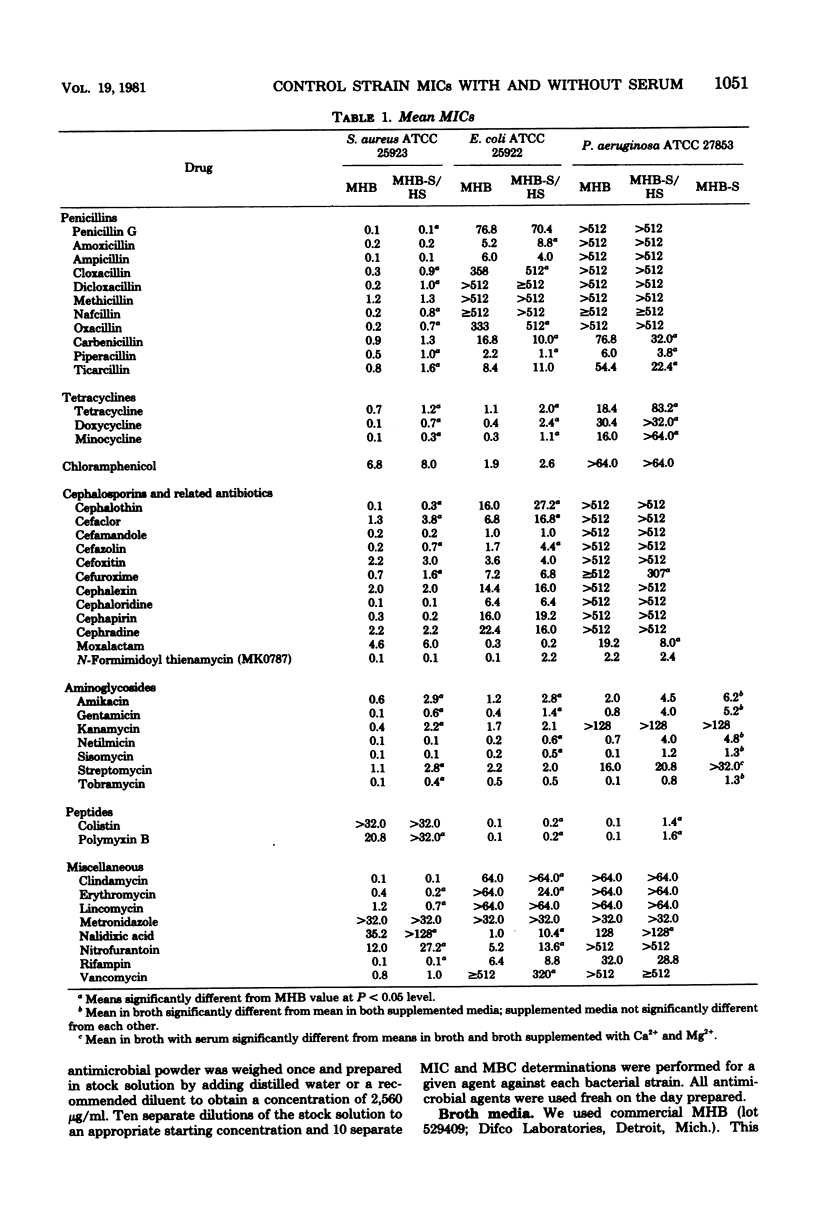
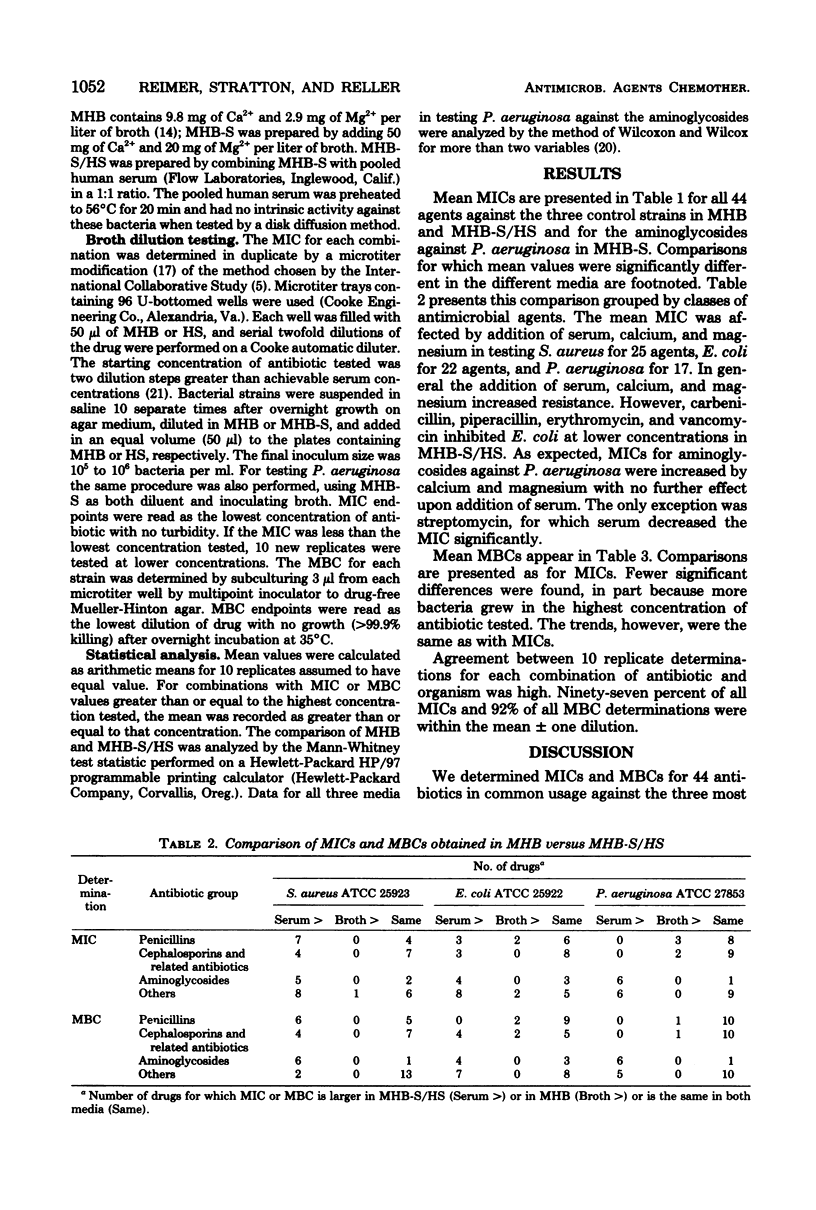
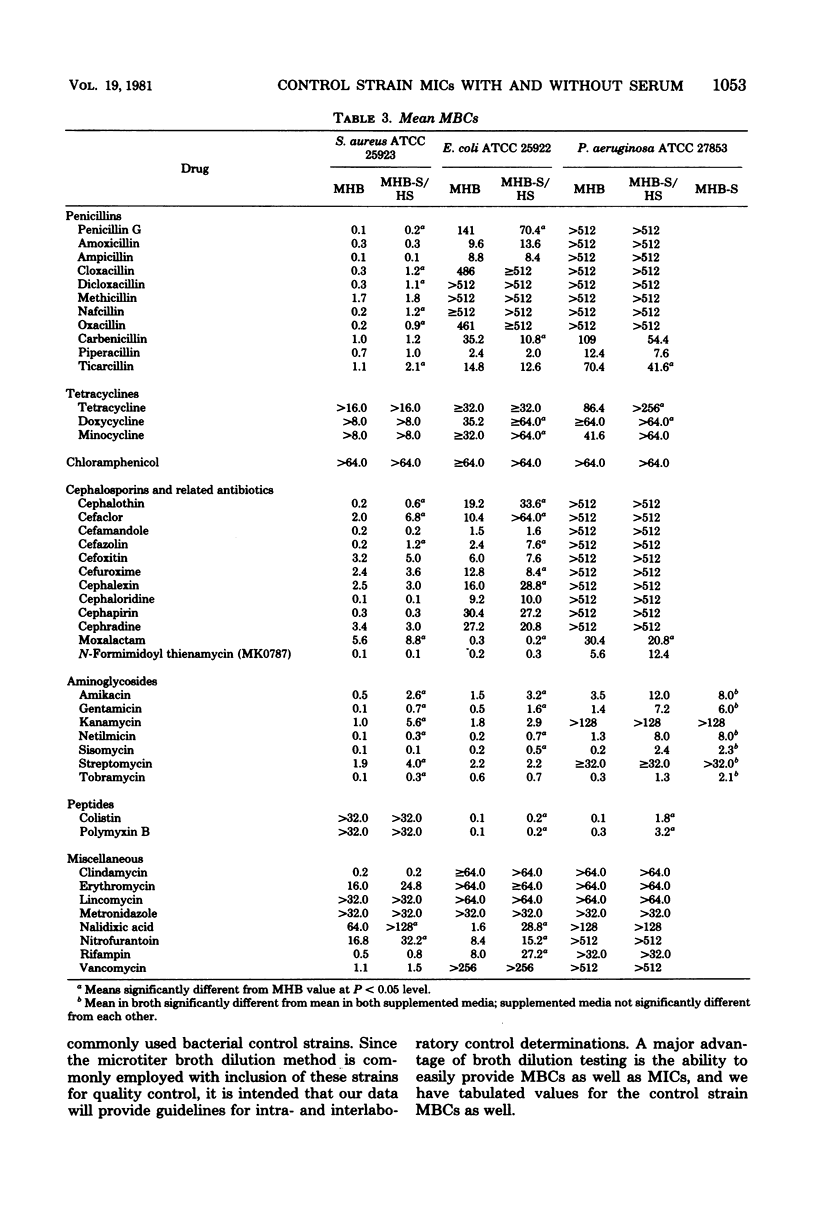
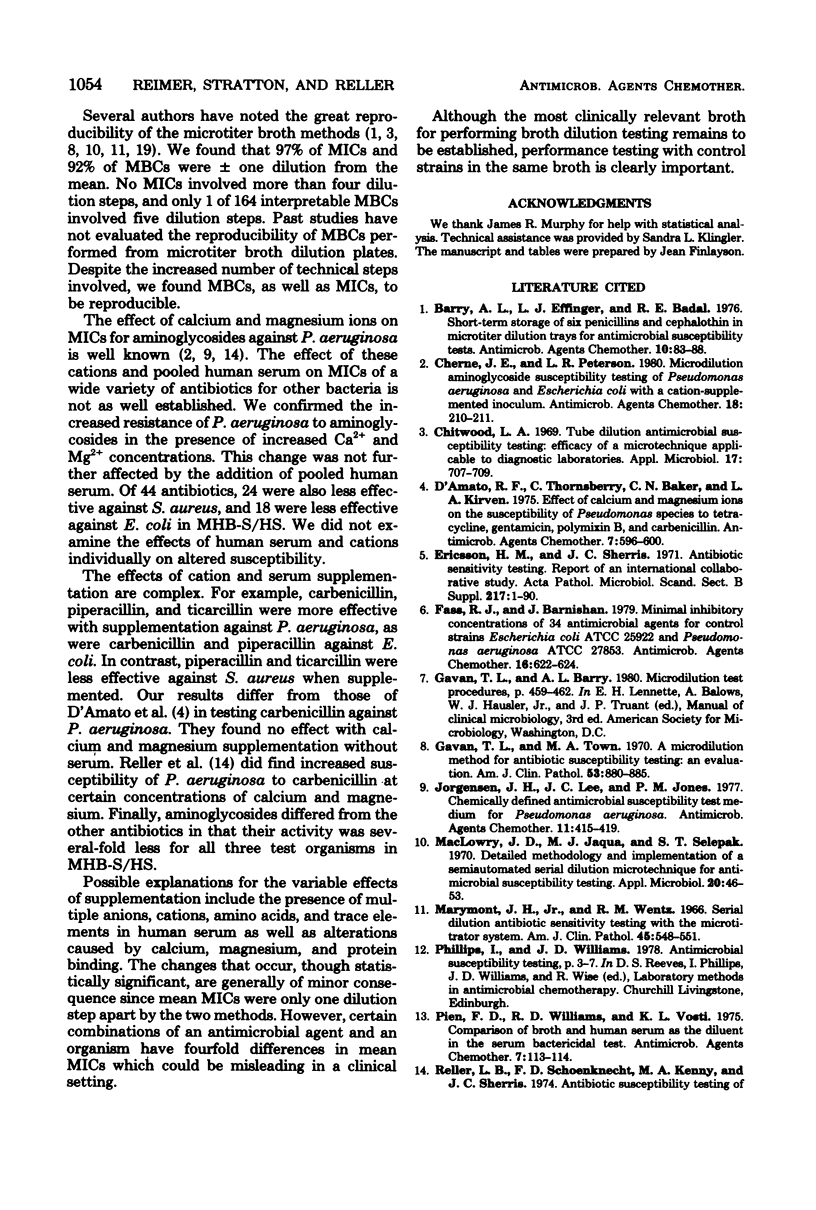
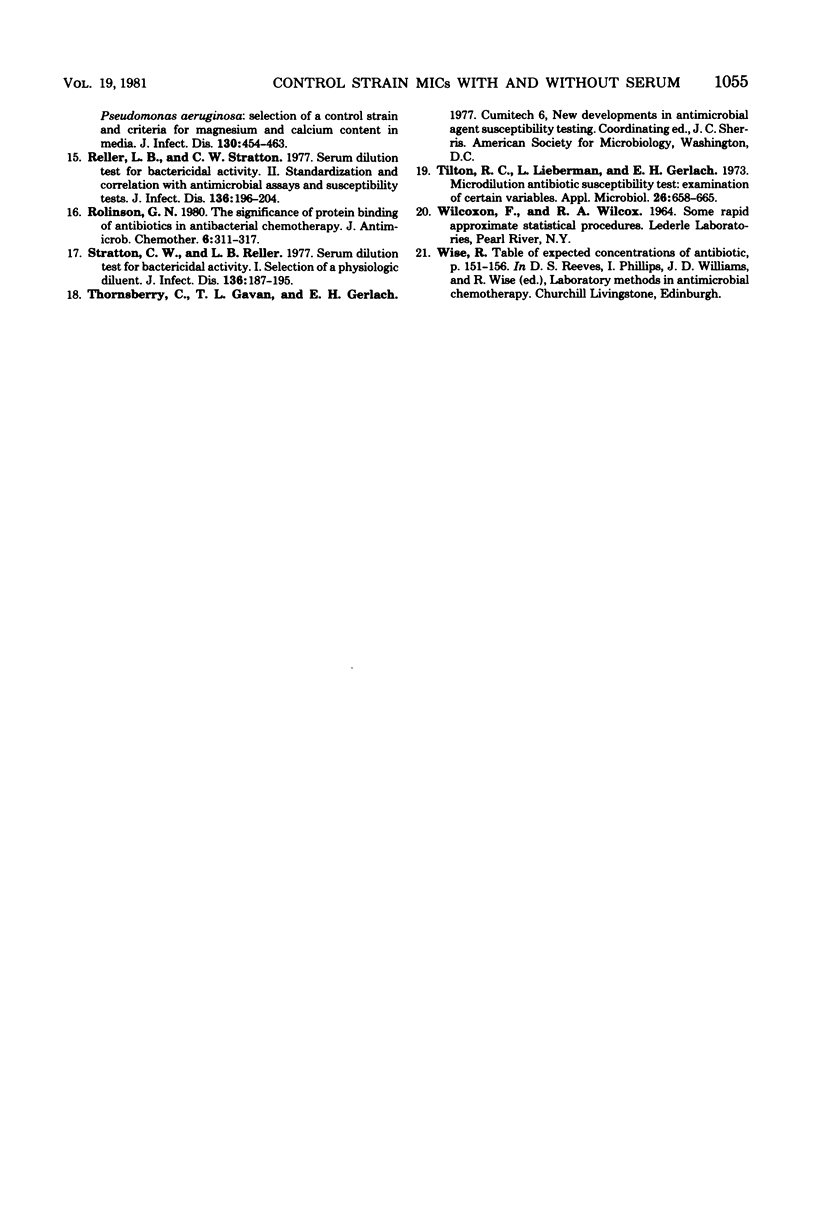
Selected References
These references are in PubMed. This may not be the complete list of references from this article.
- Cherne J. E., Peterson L. R. Microdilution aminoglycoside susceptibility testing of Pseudomonas aeruginosa and Escherichia coli with a cation-supplemented inoculum. Antimicrob Agents Chemother. 1980 Jul;18(1):210–211. doi: 10.1128/aac.18.1.210. [DOI] [PMC free article] [PubMed] [Google Scholar]
- Chitwood L. A. Tube dilution antimicrobial susceptibility testing: efficacy of a microtechnique applicable to diagnostic laboratories. Appl Microbiol. 1969 May;17(5):707–709. doi: 10.1128/am.17.5.707-709.1969. [DOI] [PMC free article] [PubMed] [Google Scholar]
- D'amato R. F., Thornsberry C., Baker C. N., Kirven L. A. Effect of calcium and magnesium ions on the susceptibility of Pseudomonas species to tetracycline, gentamicin polymyxin B, and carbenicillin. Antimicrob Agents Chemother. 1975 May;7(5):596–600. doi: 10.1128/aac.7.5.596. [DOI] [PMC free article] [PubMed] [Google Scholar]
- Fass R. J., Barnishan J. Minimal inhibitory concentrations of 34 antimicrobial agents for control strains Escherichia coli ATCC 25922 and Pseudomonas aeruginosa ATCC 27853. Antimicrob Agents Chemother. 1979 Nov;16(5):622–624. doi: 10.1128/aac.16.5.622. [DOI] [PMC free article] [PubMed] [Google Scholar]
- Gavan T. L., Town M. A. A microdilution method for antibiotic susceptibility testing: an evaluation. Am J Clin Pathol. 1970 Jun;53(6):880–885. doi: 10.1093/ajcp/53.6.880. [DOI] [PubMed] [Google Scholar]
- Jorgensen J. H., Lee J. C., Jones P. M. Chemically defined antimicrobial susceptibility test medium for Pseudomonas aeruginosa. Antimicrob Agents Chemother. 1977 Mar;11(3):415–419. doi: 10.1128/aac.11.3.415. [DOI] [PMC free article] [PubMed] [Google Scholar]
- MacLowry J. D., Jaqua M. J., Selepak S. T. Detailed methodology and implementation of a semiautomated serial dilution microtechnique for antimicrobial susceptibility testing. Appl Microbiol. 1970 Jul;20(1):46–53. doi: 10.1128/am.20.1.46-53.1970. [DOI] [PMC free article] [PubMed] [Google Scholar]
- Marymont J. H., Jr, Wentz R. M. Serial dilution antibiotic sensitivity testing with the microtitrator system. Am J Clin Pathol. 1966 May;45(5):548–551. doi: 10.1093/ajcp/45.5.548. [DOI] [PubMed] [Google Scholar]
- Pien F. D., Williams R. D., Vosti K. L. Comparison of broth and human serum as the diluent in the serum bactericidal test. Antimicrob Agents Chemother. 1975 Jan;7(1):113–114. doi: 10.1128/aac.7.1.113. [DOI] [PMC free article] [PubMed] [Google Scholar]
- Reller L. B., Stratton C. W. Serum dilution test for bactericidal activity. II. Standardization and correlation with antimicrobial assays and susceptibility tests. J Infect Dis. 1977 Aug;136(2):196–204. doi: 10.1093/infdis/136.2.196. [DOI] [PubMed] [Google Scholar]
- Rolinson G. N. The significance of protein binding of antibiotics in antibacterial chemotherapy. J Antimicrob Chemother. 1980 May;6(3):311–317. doi: 10.1093/jac/6.3.311. [DOI] [PubMed] [Google Scholar]
- Stratton C. W., Reller L. B. Serum dilution test for bactericidal activity. I. Selection of a physiologic diluent. J Infect Dis. 1977 Aug;136(2):187–195. doi: 10.1093/infdis/136.2.187. [DOI] [PubMed] [Google Scholar]
- Tilton R. C., Lieberman L., Gerlach E. H. Microdilution antibiotic susceptibility test: examination of certain variables. Appl Microbiol. 1973 Nov;26(5):658–665. doi: 10.1128/am.26.5.658-665.1973. [DOI] [PMC free article] [PubMed] [Google Scholar]


